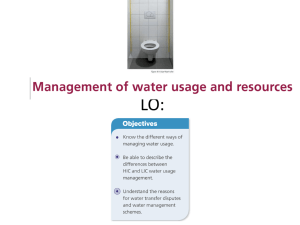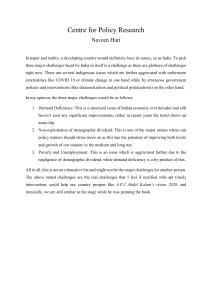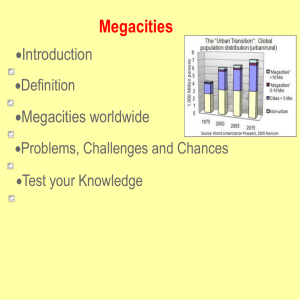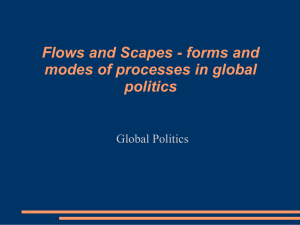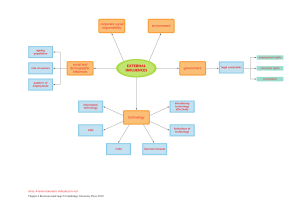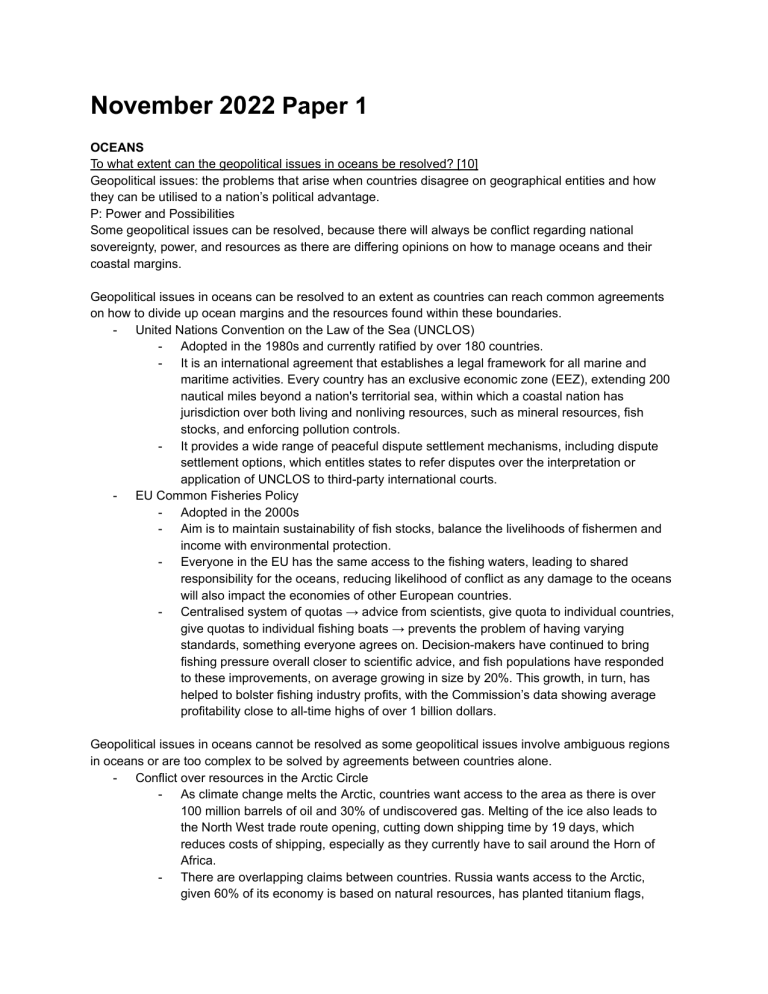
November 2022 Paper 1 OCEANS To what extent can the geopolitical issues in oceans be resolved? [10] Geopolitical issues: the problems that arise when countries disagree on geographical entities and how they can be utilised to a nation’s political advantage. P: Power and Possibilities Some geopolitical issues can be resolved, because there will always be conflict regarding national sovereignty, power, and resources as there are differing opinions on how to manage oceans and their coastal margins. Geopolitical issues in oceans can be resolved to an extent as countries can reach common agreements on how to divide up ocean margins and the resources found within these boundaries. - United Nations Convention on the Law of the Sea (UNCLOS) - Adopted in the 1980s and currently ratified by over 180 countries. - It is an international agreement that establishes a legal framework for all marine and maritime activities. Every country has an exclusive economic zone (EEZ), extending 200 nautical miles beyond a nation's territorial sea, within which a coastal nation has jurisdiction over both living and nonliving resources, such as mineral resources, fish stocks, and enforcing pollution controls. - It provides a wide range of peaceful dispute settlement mechanisms, including dispute settlement options, which entitles states to refer disputes over the interpretation or application of UNCLOS to third-party international courts. - EU Common Fisheries Policy - Adopted in the 2000s - Aim is to maintain sustainability of fish stocks, balance the livelihoods of fishermen and income with environmental protection. - Everyone in the EU has the same access to the fishing waters, leading to shared responsibility for the oceans, reducing likelihood of conflict as any damage to the oceans will also impact the economies of other European countries. - Centralised system of quotas → advice from scientists, give quota to individual countries, give quotas to individual fishing boats → prevents the problem of having varying standards, something everyone agrees on. Decision-makers have continued to bring fishing pressure overall closer to scientific advice, and fish populations have responded to these improvements, on average growing in size by 20%. This growth, in turn, has helped to bolster fishing industry profits, with the Commission’s data showing average profitability close to all-time highs of over 1 billion dollars. Geopolitical issues in oceans cannot be resolved as some geopolitical issues involve ambiguous regions in oceans or are too complex to be solved by agreements between countries alone. - Conflict over resources in the Arctic Circle - As climate change melts the Arctic, countries want access to the area as there is over 100 million barrels of oil and 30% of undiscovered gas. Melting of the ice also leads to the North West trade route opening, cutting down shipping time by 19 days, which reduces costs of shipping, especially as they currently have to sail around the Horn of Africa. - There are overlapping claims between countries. Russia wants access to the Arctic, given 60% of its economy is based on natural resources, has planted titanium flags, - mapping the continental shelf, even engaging in military activity like Operation Red Sea. USA and Canada have looked into fracking, Canada is looking to assert sovereignty over the trade route, disagreements on whether it should be considered an international route, as it will have ramifications on Canada’s spending as they will need to provide icebreakers and rescue teams. Cannot be resolved in the near future as the divisions are too ambiguous and there is currently no international law on the Arctic and management of its resources. Paris Agreement and climate change - Created in 2015 and ratified by over 180 countries - Aim is to maintain global temperatures to be below 2C, and 1.5 if possible by 2030 → commonly seen as a threshold before the point of no return for most habitats - It is important that carbon emissions are minimised as CO2 emissions rising from 200 ppm to 400 ppm in the atmosphere has caused ocean acidification to occur due to CO2 dissolving as carbonic acid, pH fell from 8.2 to 8.1, affecting biodiversity - Also caused sea level rise, such as in Kiribati which is expected to be completely submerged by the end of the century - However, it is very hard to manage who is in charge of what part of the ocean, especially when it is then ‘high seas’ which requires global responsibility - Therefore it can probably never be resolved due to the inability to divide up responsibilities for maintaining optimal conditions in the ocean EXTREME ENVIRONMENTS Examine the challenges of managing the impacts of global climate change on communities in hot, arid environments. [10] Climate change: the long-term shift in temperature and weather patterns Hot, arid environments: a form of extreme environment that receives less than 250mm of rain per year and experiences huge ranges in temperature from very hot to very cold P: People Climate change will inevitably impact communities living in hot, arid climates, but there are ways to reduce the challenges so they are more sustainable for local communities. China and the Great Green Wall - In the 1980s, China decided to begin an afforestation program to combat desertification, stop sandstorms and reduce their carbon footprint in the Gobi Desert. The plan was to plant 4500 km of trees and increase forest cover as it was at an all-time low of 8% at the time. They managed to plant over 66 million trees. - However, there were several problems - Monoculture forests → does not contribute to biodiversity → lost over 1 million poplar trees due to disease - Trees needed a lot of water → caused smaller vegetation to die, led to a loss of topsoil, contributing to more nutrient loss and a positive feedback loop of desertification - Farmers were deforested forests to grow monoculture trees due to financial incentives to plant trees in barren areas, going against the whole point of the program - China tried to resolve the issue in several ways - Changed the law in the 2000s to prevent deforestation - Utilised technology to map trees and plant plants that do not need much water and are also local species - Trained farmers and other volunteers on how to better afforest areas - Sandstorms reduced by 20% by 2015 Saudi Arabia and desalination - Climate change has increased global temperatures → the aridity of deserts → less fresh water is present as precipitation. Saudi Arabia also has no permanent lakes or rivers, and they only have enough groundwater to last them another decade due to the population drawing too much from the aquifers. - Desalination makes up 90% of the water supply. It involves using reverse osmosis to extract salt from seawater and make it drinkable and usable. The biggest plant produces 1.4 million gallons of water per day - Problems - Very energy intensive → very expensive and unsustainable as Saudi Arabia relies on income from oil and gas which will one day run out - Produces brine → salty and warm affecting biodiversity and their reproductive processes in the gulf - Overuse due to Westernised consumer focused lifestyle → twice the daily average at 90 gallons per day per person Greening the Desert project in Jordan - Jordan used to be extremely dry with saline soils May 2019 Paper 1 OCEANS Examine why some hurricanes could have a greater impact than others on coastal margin landscapes [10] Hurricanes are tropical storms with a constant wind speed of more than 75 miles per hour. They form when warm ocean air rises, cools and condenses to form clouds, and begin to spin in a circular motion, before moving westward, gaining energy from the further evaporation of more warm water. Hurricanes are strongest when they reach the coast as the coast is the first point of contact for hurricanes when they reach land, making the coast inherently vulnerable to hurricanes and its related hazards. However, populations can use various pre and post-management methods to reduce their risk from hurricanes, with the processes itself affected by economic status of the country. Thus, it can be argued that LICs will experience a greater impact from hurricanes at the coast compared to HICs, which will be explored through contrasting case studies of the Philippines and Hong Kong. Disaster crunch model The idea that someone’s risk to a hazard is determined by their vulnerability alongside the magnitude of the hazard itself. People are vulnerable when they are unable to adequately anticipate, withstand and recover from a hazard. The root causes lead to dynamic pressures that explain how the unsafe conditions have arisen and persisted. LIC - Typhoon Haiyan, Philippines 2013 High risk - 60% of the population living on the coast → vulnerable to waves and flooding - 40% in poverty, living on less than 2 USD a day → lack financial resources for insurance, infrastructure, and education. Most houses were made of wood. - Over 300 km/h in winds, rainfall reached up to 200 mm in six hours, storm surges of up to 7m high Lack of preparation - 20% of roads were paved - Lack of education for the public - No pre-warming beforehand → unable to evacuate - Over 4 million people displaced - Over 6000 people killed Lack of disaster response / inadequate secondary response - Shortage in food supplies led to stampeded and 8 people died - Over 100,000 farmers were affected, their main crops such as coconut trees were destroyed, over 6 million in damages HIC - Typhoon Mangkhut, 2018 Pre-hazard preparation - HK government held an inter-departmental meeting to discuss possible responses to the storm - The Weather Observatory monitored the typhoon, most people had smartphones and could track the storm, the TV and news. The Hong Kong Observatory issued the Standby Signal No. 1 when Mangkhut was 1,110 kilometres away from Hong Kong, told citizens to ‘stand-down’ → clear, decisive message enabled coordinated response. - Citizens living in Tai O and Lei Yue Mun were evacuated from these low-lying areas that have historically been very prone to storm surge. - Stable infrastructure made of concrete, sea walls that reduce the impact of waves Quick disaster response - No one was killed - People hurt was sent to hospital via ambulance quickly - Weather Observatory kept monitoring the situation - Police and firefighters were on stand-by in case of emergency - Some minor flooding in low-lying areas, drainage system enabled water to leave within 1-2 days HICs tend to be better prepared and more able to deal with the aftermath of a hurricane. LICs tend to be less coordinated and unable to respond in a timely manner to a hazard. At the same time, LICs like the Philippines are more likely to experience hazards like hurricanes as they are in the equator where the warmest water tends to be. However, it is possible for HICs to give aid, teach LICs and give them support to deal with hazards, able to combat coastal hazards. Examine why mass movement hazard risk in some places could change in the future. [10] Mass movement: - The transfer of rock and soil down-slope due to gravity. Can be classified based on whether it's fast/slow and dry/wet. Some examples include: soil creep, liquefaction, avalanches, landslides, mudflows, solifluction, rockfall, earthflow, lahar HIC - Risk decreases - funding allows for prevention, mitigation, forecasting, community preparedness, resilience to be developed - slope drainage - planting trees on slopes - terracing of steep slopes - wire netting - land-use zoning = different land uses may be prevented from locations in a zone that is known to be at risk of a hazard eg. densely populated buildings/hospitals/fire services should NOT be built close to areas at risk of landslides Construction sector - building codes upheld Community level - understanding of hazard events which influences preparedness, evacuation procedures LIC - risk increases Urbanisation in NICs, increasing proportion of people moving from rural to urban areas, most urban areas are in seismic zones ____, greater concentrations of people in urban areas → higher death toll, more people at risk when mass movements do occur high levels of inequality → forced to move into hazard-prone, risky areas (urban sprawl contributes to the spread of housing to the periphery of cities), slums often near steep slope bases, don't have enough income to stabilise slopes, e.t.c. Rapid urban development combined with environmental degradation (from changing climate and land use)→ disaster risk increases to dangerous levels - in general, LICs carry a disproportionate burden of natural hazards, including a huge disparity in death rates. November 2019 Paper 2 “A sustainable balance between population and resources can be best met by the circular economy.” To what extent do you agree with this statement? [10] Sustainable development: Development that allows for the needs of current generations to be met without compromising the ability of future generations to meet their own needs Circular economy: A model of production and consumption, which involves sharing, leasing, reusing and recycling existing materials and products for as long as possible P: Process, Possibilities Outline the model of the circular economy - In modern society, the most common process, or production model is ‘take, make, and dispose’ which involves extracting large quantities of natural resources and creating new products - - continuously, with old products dumped into landfills or burnt, releasing large quantities of greenhouse gases and toxic chemicals In a circular economy model, the aim is to minimise resource inputs, waste/pollution, and emissions by working in closed loops. After a product reaches the end of its life cycle, the appliance is fixed or its parts are reused in other products. Reusing goods decreases the demand for goods and therefore raw materials, with products designed to last, allowing for the decoupling of economic activity with the continuous extraction of raw materials. It is a systematic approach with processes that tackles global challenges such as climate change and pollution, regenerates natural systems, generates business and economic opportunities, and provides societal and environmental benefits. It builds resilience against future disruptions like pandemics or extreme weather events. Agree - The global middle class is expected to rise by nearly 160 million people by 2030, with half of the world’s population having an income level that allows them to buy from global brands, lifestyle products, and the newest electronic appliances. - The global middle class is associated with an increase in carbon footprint —> diet changes, increased use of energy, land use changes - Linear model —> e-waste in Ghana from core to periphery —> over 150,000 tonnes of waste every year, e-waste is burnt or taken apart to provide resources for Ghanians / they can sell to other companies so they can continue creating new products —> provide jobs for 100000 people —> toxic chemicals in the water, increase in cancers and respiratory diseases, chances of injuries from burns or cuts - Circular model —> HK —> over 7 million people and one of the highest population densities in the world —> HDI is one of the highest in the world —> ecological footprint is 1.9 hectares per person, above sustainable global average —> WEEE park (waste, electrical and electronic equipment) helps recycle 70000 tonnes of e-waste a year, five stages with different processes to dismantle and refurbish old electronics, 3000 appliances given to charity, educated over 10000 people, recycling fee when buying new electronics to encourage people to fix their old ones instead of buying new ones —> through combination of education, technical cycle, technology, able to use principles of circular economy to create possibilities for sustainable development —> seen through increase in green initiatives Disagree - Sustainable development involves quantifying and understanding the risks, trade-offs, and unintended consequences from a life cycle perspective across the entire supply chain. It is not just conservation / preservation, eco-friendly options, or switching to alternative energy sources. It is a feature of a system in its entirety, not a singular focus on any individual part. For example, a Tesla electrical vehicle is not sustainable if we include the unquantified and unaccounted social and environmental impacts that span the life cycle of a lithium ion battery from mining, processing, smelting, trade, and transportation across a global supply chain. The geopolitics and human rights violations involved in such processes with the potential of working in sensitive environments or collaborating with corrupt regimes with weak environmental laws will affect its sustainability. - Circularity itself does not mean sustainability. Comprises vast versatility, wide-ranging scope and applications, and ambiguities around definitions. For example, bioplastics, biodegradable and recyclable, but poorly from energy and resource standpoint as it requires lots of land to produce the materials especially if it is starch-based, or bio fuels like ethanol that could lead to monoculture, loss of biodiversity, even if the process of making the fuel is efficient, no waste Agree with the statement to an extent Circular economy can help mitigate environmental problems. For a successful transition to CE, need common understanding and approach —> circular strategies in national priorities, federal and state discussions, corporate sustainability plans, Acknowledge circular economy relationship and contributions to sustainability and long-standing waste management principles, consistently collecting data at the micro and macro levels, incorporate systems-level thinking into new policies, collaborate with stakeholders to minimise the impacts of sourcing and extraction and improve recycling and waste management Countries, individuals, businesses can work together to implement CE, create new business models, encourage innovative technologies, foster supply chain collaboration and build a resilient economy resistant to global disruptions. The greatest global demographic challenge is the growth of overpopulated megacities.” To what extent do you agree with this statement? [10] Demographic challenges: problems related to the population structure of a country Megacities: a city of more than 10 million people P: Place Stance: Somewhat agree, because while ageing is a large issue, other issues such as the demographic dividend and the growth of megacities may also become a problem in the future. Ageing: Japan - Longest life expectancy in the world of 85 years - Currently 100 million people, expected to drop to 45 million by 2100, as fertility rate is 1.9, below the replacement rate of 2.1 - Problems: drop in tax revenue from working-age population, increase in cost of pensions, residential care, and healthcare, high dependency ratio puts a burden on the work-age population - Solutions: Economic migration, pro-natalist policies (New Angel Plan), more senior friendly facilities Demographic dividend: Ethiopia - Not all countries will experience an ageing population in the near future - Ethiopia has 115 million people, 70% under 30 years of age and 50% under 15 years of age - Birth rate is 4.1, considered relatively high - They will face another challenge which is the demographic dividend → rapid economic growth caused by improved reproductive health, declining fertility rates, and a shift in the population structure where there is a high ratio of working-age population - Benefits: more people working, paying taxes, less spent on education and healthcare, empowerment of women so more people working, more investment into each child so improved quality of life, increased economic growth - Issues: if the birth rate is not controlled by contraception/education/family planning, it may lead to overpopulation. If there is not enough investment into education and healthcare, it may lead to the population being less productive than what they could be. - Solutions: Research into the demographic dividend such as by the government, increase in number of female teachers and bathrooms, empowerment of women to enter school (now 90% enrollment in primary) Megacities: Shenzhen - Megacities are cities of more than 10 million people - - The number of megacities is expected to increase from 20 to 40 by 2050 Shenzhen is a city of 20 million people, up from 300,000 in 1990 Designated a Free Economic Zone in 1980s → rapid economic growth of 25% a year → place of innovation and trade → lots of migrant workers moved to Shenzhen to find work and helped further the secondary and quaternary industries Issues: lack of regulation for migrant workers, overcrowding with poor quality housing, migrant workers get less opportunities for jobs, healthcare, and education Ageing is a serious problem on the global scale → most apparent in HICs like Japan that are in the late stages of development → however it is not the only problem as it depends on the population structure of a country Demographic dividend → more prevalent in LICs like Ethiopia as they have a young population → need proper investment so they can take advantage of the rapid economic growth in the coming decades Megacities → megacities are appearing all over the world, whether it is HICs like Japan, MICs like China, or LICs like Mexico. The example used is from China, but the problems faced there will likely be faced all over the world regardless of the developmental stage due to the influx in population. Thus ageing or demographic dividend depends on the population structure, but issues like megacities would probably be the most serious as it will appear no matter what developmental stage of the country. May 2019 Paper 2 “Responding to climate change is more important than working towards the UN Sustainable Development Goals.” To what extent do you agree with this statement? Climate change: the long-term shifts in the Earth’s temperature and weather patterns UNSDGs: a series of 17 global goals that seeks to be a blueprint for peace and prosperity for people and the planet P: Power, Process Stance: Do not agree, because climate change and the UNSDGs are interconnected Responding to climate change is more important - Climate change occurs due to the enhanced greenhouse effect → anthropogenic causes such as agriculture and increase combustion of fossil fossil fuels for transport/energy/industry has lead to increased concentrations of GHG → changing weather patterns and temperatures - Some consequences will include extreme weather conditions (e.g. Niger with desertification, 60% of the economy is based on the primary sector, affect agriculture productivity and cause food insecurity, causing forced migration), conflict due to resource insecurity (e.g. Dafar), sea level rise (e.g. Kiribati, 100,000 citizens, no part of the country is more than 1 km away from the coast, 100% is less than 1 m above sea level, infrastructure facing inundation from the sea and salinisation of water supplies) → countries will be unable to meet the UNSDGs, especially the more ambitious ones related to no poverty/hunger or global partnerships because of how insecure their regions are due to climate change. - Most of the most vulnerable countries are LICs too → lack capacity on protecting themselves from the consequences of climate change on people and the economy → focus would be on adaptation and mitigation strategies on the national scale rather than global level (e.g. Kiribati bought land on Fiji to move their population to if required, Niger is participating in the Great Green Wall initiative to combat soil erosion caused by desertification and create jobs). Responding to the UNSDGs are more important - - - - UNSDGs were developed in 2015 as a successive plan to the Millennium Development Goals (MDGs). It consists of 17 goals and over 200 indicators. Responding to the UNSDGs are more important as problems outlined by the goals (such as no poverty, protection of land and sea) require collaboration on the global level to protect and regenerate the resources available on Earth. This is especially since climate change is a ‘wicked problem’ → all the issues (e.g. food, water, energy security) are cross-boundary and require an intersectional approach between different elements (e.g. food, water, energy) of an ecosystem. Climate change is also just one aspect of the UNSDGs → if we only address climate change we will neglect other social or political aspects such as gender equality, economic well-being, and education, which are all required for a healthy, productive society. It would be better to respond to the UNSDGs rather than solely climate change, for the adaptation and mitigation of climate change can be integrated into strategies relating to the other goals as the environment underpins everything humans do anyway. Climate change is more important as we depend on the environment for survival → if we don’t combat climate change it will have knock-on effects on other parts of society such as health, wealth, education. However, the UNSDGs are also important as they are a globally agreed blueprint for enabling prosperity → it allows for shared responsibility and accountability → it is important to recognise the goals there as they allow us to see the interconnectedness of various parts of people, planet, economy. Ultimately, which one is more important will depend on the developmental stage of the country. LICs are more vulnerable to climate change as they lack the resources/manpower/political will to adapt to the changing environment and so their priorities would be protecting their populations from being hurt by climate change. However, HICs tend to be more well-prepared, so they can focus on the bigger picture and help respond to the UNSDGs → they can also help LICs by providing equipment/expertise/developmental aid. “Of all the demographic challenges nations face, ageing is the most serious.” To what extent do you agree with this statement? [10] Demographic challenges: problems related to the population structure of a country Ageing: a shift in the population structure where people aged 65+ make up the majority of the population P: People, Process, Possibilities Stance: Somewhat agree, because while ageing is a large issue, other issues such as the demographic dividend and the growth of megacities may also become a problem in the future. Ageing: Japan - Longest life expectancy in the world of 85 years - Currently 100 million people, expected to drop to 45 million by 2100, as fertility rate is 1.9, below the replacement rate of 2.1 - Problems: drop in tax revenue from working-age population, increase in cost of pensions, residential care, and healthcare, high dependency ratio puts a burden on the work-age population - Solutions: Economic migration, pro-natalist policies (New Angel Plan), more senior friendly facilities Demographic dividend: Ethiopia - Not all countries will experience an ageing population in the near future - Ethiopia has 115 million people, 70% under 30 years of age and 50% under 15 years of age - Birth rate is 4.1, considered relatively high - - - - They will face another challenge which is the demographic dividend → rapid economic growth caused by improved reproductive health, declining fertility rates, and a shift in the population structure where there is a high ratio of working-age population Benefits: more people working, paying taxes, less spent on education and healthcare, empowerment of women so more people working, more investment into each child so improved quality of life, increased economic growth Issues: if the birth rate is not controlled by contraception/education/family planning, it may lead to overpopulation. If there is not enough investment into education and healthcare, it may lead to the population being less productive than what they could be. Solutions: Research into the demographic dividend such as by the government, increase in number of female teachers and bathrooms, empowerment of women to enter school (now 90% enrollment in primary) Megacities: Shenzhen - Megacities are cities of more than 10 million people - The number of megacities is expected to increase from 20 to 40 by 2050 - Shenzhen is a city of 20 million people, up from 300,000 in 1990 - Designated a Free Economic Zone in 1980s → rapid economic growth of 25% a year → place of innovation and trade → lots of migrant workers moved to Shenzhen to find work and helped further the secondary and quaternary industries - Issues: lack of regulation for migrant workers, overcrowding with poor quality housing, migrant workers get less opportunities for jobs, healthcare, and education Ageing is a serious problem on the global scale → most apparent in HICs like Japan that are in the late stages of development → however it is not the only problem as it depends on the population structure of a country Demographic dividend → more prevalent in LICs like Ethiopia as they have a young population → need proper investment so they can take advantage of the rapid economic growth in the coming decades Megacities → megacities are appearing all over the world, whether it is HICs like Japan, MICs like China, or LICs like Mexico. The example used is from China, but the problems faced there will likely be faced all over the world regardless of the developmental stage due to the influx in population. Thus ageing or demographic dividend depends on the population structure, but issues like megacities would probably be the most serious as it will appear no matter what developmental stage of the country. May 2019 Paper 3 Using examples, analyse the links between globalisation and the rise of nationalism in some countries. [12] Globalisation is the increasing interconnectedness of the world’s economies, populations, and cultures, arising from cross-border trade of goods and services, diffusion of technology, and the flow of people, investments, and information. Meanwhile, nationalism is political movements that revolve around national independence motivated by fears of globalisation posing a threat to national sovereignty and culture. The correlation between globalisation and the rise of nationalism is apparent through examples from three places: the France Nationalistic Party in France, the Justice and Development Party in Turkey, and the U.S. Republican Party, all three of which are far-right parties fuelled by dissatisfaction with globalisation. France → France Nationalistic Party - - - - France has previously been a component of neoliberalism, the belief that the government should have minimal influence on the economy and instead leave it free for competition (including businesses from overseas) to compete with each other, in the hope that it will drive innovation and allow the public to experience lower prices. This was also a big reason why France decided to join a multi-governmental organisation like the EU as France can buy and sell goods to and from other European Union countries without any barriers or extra taxes. Instead, the increased cross-border trade of goods and services led to many businesses relocating overseas in a process known as offshoring, as the wages in Asian countries like China and Thailand are much cheaper than in France. As a result of such trends in production, led to the pattern known as an ‘elephant graph’, which shows that the average income of the working class in Eastern countries have risen by 60-70%, while the average income of the working class in Western countries like France has remained stagnant or even decreased Led to feelings of discontent by the public as they are unable to keep up with standards of living despite rising costs of living, leading to the rise of extremist parties that utilise protectionist, nationalistic messages that calls for the closing of borders for trade and immigration to regain national sovereignty sovereignty Example is the France Nationalist Party, currently headed by Marine Le Pen A right-wing party founded in the 1980s by Le Pen’s Father Wants France to leave the EU with its own ‘Frexit’, restore the frances (the main currency before the euro), and deport any illegal migrants that entered the country Won over 80 seats in the last general election, up from just 2 seats a decade before Shows the mass acceptance of the Party by the general public Suggests the main reason for nationalism is from economic uncertainty Turkey → Justice and Development Party - Turkey saw the greatest decline in democracy and the rule of law over the last decade among 137 countries in the Bertelsmann Transformation Index of 2022 - Has seen a rise in nationalism and a stronger Islamic push, with the three main reasons being the consolidation of authoritarianism, economic vulnerability and an increasinging conflictual foreign policy - After the lifting of the post-coup state of emergency in 2018, several legal provisions have restricted fundamental rights and granted extraordinary levels of powers to the executive. The rule of law have deteriorated, and opposing viewpoints are shut down, blocked, or arrested on Turkish social media, undermining the fundamental aspects of a democratic system - Further exacerbated by the COVID pandemic, disruptions to global supply chains made prevalent by globalisation, lack of organisation, aggravated these structural problems and imbalances in the Turkish economy. - These domestic trends in turn have influenced Turkey’s foreign policy. First, Turkey is more inclined to take unilateral action in the region, as exemplified by its drilling activities in the eastern Mediterranean, and military operations in northern Syria and in Libya. These operations, launched in complete disregard for its partners, have increased tensions between Turkey, and its allies in NATO and the European Union. Second, Turkey started to use a more assertive foreign policy balancing strategy to further its interests and consolidate executive power. Flexible alignments guided by short-term interests and pragmatism have made the country an unpredictable and unreliable actor in international relations. Third, Turkey increasingly opts for the use of force, instead of diplomacy, to resolve international issues. Fourth, foreign policymaking has become less institutionalised, with the president’s palace monopolising foreign policy decision-making. This has not only blurred the boundaries between external and domestic politics but has also rendered Turkish foreign policy incoherent and inconsistent USA → Donald Trump and the America First movement Perhaps the most important reason for this shift is the perceived sense of being exploited at the hands of emerging global powers that are getting ahead economically and technologically. And they are doing so by not being necessarily democratic or upholding human rights. Moreover, as the sources of Western economic wherewithal dwindle, they have started to challenge the very basis of their strength, such as multiculturalism and diversity. At the core of this belief is a feeling that US is being unfairly treated within the very system it helped create, and that Paris agreement on climate change would have likely further strangulated American economic growth under the burden of strenuous regulations. Under America First, Trump prefers bilateral format as opposed to the complexities involved in multilateral deals. We reject globalism and embrace the doctrine of patriotism,” Trump said in a clear rejection of the half-century old international institutions that emerged from the devastation of World War II. It was a declaration of the supremacy of sovereignty, and the idea that all nations should embrace their own versions of his “America First” foreign policy approach. From there, Trump’s speech went around the globe reprimanding ungrateful allies, lambasting bad trade deals and criticizing other agreements that enabled the world to take advantage of America. “The U.S. will always choose independence and cooperation over global governance, control and domination,” he said, defending his Administration’s retreat from U.N. organizations like the International Criminal Court, Human Rights Council and a global compact on migration. Part of this, Trump said, would be paring back on U.S. contributions to the U.N. peacekeeping operations around the globe from today’s 28.5%, or $1.9 billion, to 25%, or $1.7 billion. Trump, meanwhile, believes that international collaboration has resulted in the U.S. being swindled. For decades, he said, the United States opened its economy with few conditions, allowing foreign goods from all over the world to flow freely across U.S. borders. “We will no longer allow our workers to be victimized, our companies to be cheated and our wealth to be plundered and transferred,” Trump said, detailing his rationale to slap China with another $200 billion in import tariffs with a promise to implement more, should Beijing retaliate.
